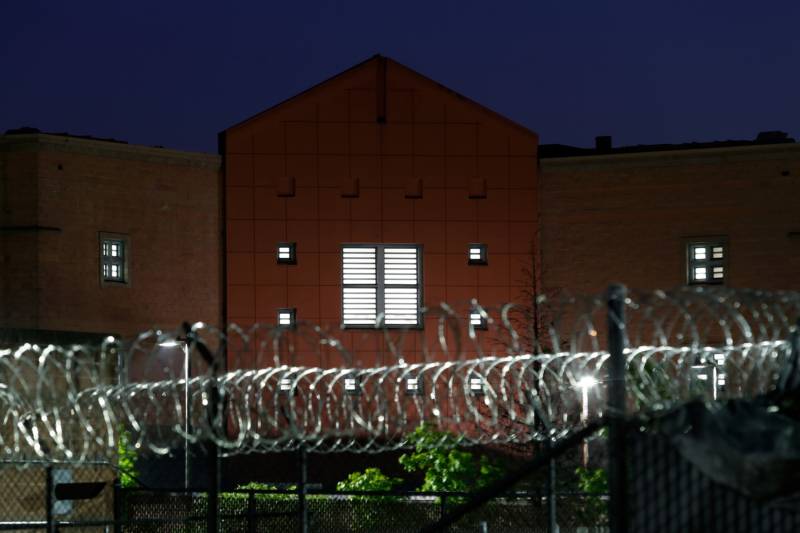A Sonoma County sheriff’s correctional deputy resigned in 2017 after his bosses sought to fire him for fondling and kissing a female inmate under his guard at the county jail, according to documents released last week under California’s new police transparency law.
Former Sonoma County Sheriff's Deputy Groped and Kissed Inmate, Avoided Criminal Charge

Sheriff’s investigators forwarded their criminal case against Deputy Garrett Paulson to the Sonoma County District Attorney for charges stemming from sexual contact with an inmate, the documents show. But three months before Paulson resigned, District Attorney Jill Ravitch’s office declined to prosecute, saying the victim would not cooperate, the records show.
Joan Croft, a district attorney spokeswoman, said the internal affairs documents released Wednesday by the Sheriff’s Office contain more information than prosecutors had when they made their decision in May 2017 not to press charges. Croft said she could not comment further until the files were reviewed by the office.
An attorney for the female inmate, however, insisted she did cooperate with district attorney officials at the time.
She told an investigator the two had kissed, and that she stripped for Paulson, but she did not confirm sexual contact that he later admitted to, according to the records, including that he had touched her breast or buttocks, said Izaak Schwaiger, a Sonoma County civil rights attorney.
Paulson, reached via email, declined to comment for this story. He began Army training around the time he resigned, according to a Facebook post in July 2018. The Army could not immediately confirm his service.
The records detailing the inquiry into Paulson’s on-duty behavior were among five internal investigation files made public by the Sonoma County Sheriff’s Office on Wednesday under the police transparency law, Senate Bill 1421, that went into effect in January. The disclosure reflects a profound shift in California, where prior law barred most police disciplinary files and internal investigations from public disclosure.
Paulson, now 24, had worked for the Sheriff’s Office for just over a year when, in March 2017, his bosses started investigating him for sexual misconduct based on allegations made by a woman in the county’s main jail, which can house up to 284 female inmates.
The witness said in one instance she saw Paulson, who she referred to as “Perv Runner,” spend 15 minutes obstructed from view in another female inmate’s cell.
“Inmate (name redacted) reported hearing moaning during this time,” the documents say. The witness reported her allegations on March 15. They included two separate incidents, though investigators could only document one. In the disclosed records, the county redacted the victim’s name and the name of the inmate who reported the activity.
It is a crime under state and federal law for correctional guards to have any sexual contact with inmates.
Sheriff Mark Essick said his department has a zero‐tolerance policy on sexual abuse, harassment or assault of detainees.
He said investigators intercepted Paulson at the start of his next shift on March 17.
“We moved pretty darn fast on this,” Essick said. “An allegation of sex between a correctional deputy and an inmate, that’s a big deal.”
The internal affairs investigation would ultimately conclude that on or about March 13, Paulson had violated department policies barring sexual contact of any kind with inmates and voyeurism. And it found the deputy didn’t report his misconduct to superiors.
Paulson admitted to investigators that he used a closet door in the jail to conceal his location while he stood at the entry to the woman’s cell.
“Paulson stated he probably began touching (redacted name’s) ‘breast’ to her ‘butt,’” records recounted.
Paulson asked her to take her clothes off while he watched, and she did, according to the records. Paulson told investigators he also looked the inmate up on Facebook and one of the jail database systems.
Another guard at the jail reported to investigators that the woman showed concern for Paulson and didn’t want to get him in trouble.
“She said inmates were making rumors because she said Correctional Deputy Paulson was ‘Hot,’” the report says. “(The woman) said she was not a victim of a sexual assault and did not need an advocate.”
The woman was interviewed twice, on March 16 and March 22, and stated that she had initiated the contact with Paulson and did not want him to get into trouble. She also threatened to sue the county if that happened or if she was moved in the jail.
“Frankly, it doesn’t matter,” Essick said when asked last week about whether the inmate consented to the behavior. “A correctional deputy is not to have a relationship with an inmate, period.”
Transcripts of investigators’ interviews with Paulson and the woman were not included in the released records.
By May 22, Ravitch’s office had made the decision that it would not pursue charges, citing a “lack of victim cooperation,” according to the records.
The woman had previously declined to speak to an investigator from the office because she wanted her attorney present, said Schwaiger. He advised the District Attorney’s Office in a May 5 letter that he was representing the woman. The next time he heard from prosecutors was May 23, after the decision had been made to drop the case, according to the records.
On June 15 — a week before the Sheriff’s Office served Paulson with a notice of termination, signed by then-Sheriff Steve Freitas — the woman had her only substantive interview with an investigator from the District Attorney’s Office, Schwaiger said.
“She answered every single question, and the district attorney investigator took the report back to the district attorney and the district attorney determined that no crime had been committed,” Schwaiger said. “That might be the correct determination, it might be, but that was because that’s what the DA decided, not because my client did not cooperate.”
Ravitch refused an interview request Saturday. In a text response to a phone call, she said Schwaiger could call her office with additional information. She declined further comment.
Paulson initially appealed the firing notice, but records show he resigned two months later, in August 2017.
A search of his name in the Sonoma County Superior Court website showed no criminal or civil cases.
An Army spokeswoman said applicant screening includes an extensive background check and interviews “to determine if applicants have a history of conduct that shows they have questionable moral character or that they hold views that are inconsistent with Army values.”
Essick said Paulson’s was the only case of sexual misconduct he is aware of involving a correctional deputy and an inmate in the Sonoma County jail.
Public disclosure of the case comes less than a year after Sonoma County agreed to pay $1.7 million to settle a lawsuit filed by former inmates at the jail who said they were physically and verbally abused by correctional deputies in 2015 as part of a formal “yard counseling” policy.
The suit prompted the office to retrain jail employees on use‐of‐force procedures. The jail deputies, who number over 200, are slated to begin using body‐worn cameras in May, said Sgt. Spencer Crum, a Sheriff’s Office spokesman.
Essick said he’s committed to improving jail video surveillance, which currently covers only a third of all cell blocks. He needs roughly an additional $3 million in county funds do so, he said.
Sonoma County’s correctional deputies undergo mandatory sex assault and abuse prevention training when they are hired and every two years thereafter. Paulson’s training came when he joined the department in 2016, documents show.
Essick said he was surprised to learn the District Attorney’s Office did not have all records in the Sheriff’s Office case against Paulson when it made the decision not to pursue charges.
Essick said it was a good thing that prosecutors now have all the relevant files.
“Maybe there’s information there that would help them take a second look at this case,” he said.
This story was coproduced with the Press Democrat as part of the California Reporting Project, a collaboration of more than 30 newsrooms across the state to obtain and report on police misconduct and serious use-of-force records unsealed in 2019.

